 |
Notre Dame kicked off its football season Sept. 2, showcasing the $400 million stadium upgrades.
GETTY IMAGES |
Shortly before Notre Dame kicked off its season against Temple, the sellout crowd of 77,622 shifted its attention to the new video board at the south end of Notre Dame Stadium. The big screen took fans inside the home locker room for a tight shot of Coach Brian Kelly leading the team prayer before the Fighting Irish walked down a cramped stairwell and slapped the iconic “Play Like a Champion Today” sign on their way to the field.
The prayer and the walk past the sign have been pregame rituals for decades in South Bend. But on Sept. 2, the first home football game after a massive stadium renovation, fans in attendance viewed those images live for the first time.
The board is just one piece of the $400 million facelift at the 87-year-old facility, one of the last FBS stadiums to install one.
The improvements dramatically shift what had been a neo-traditional game-day experience, where the Notre Dame marching band provided most of the entertainment for 80,000 fans sitting on wood bench seats. Now, it’s much more. The video board, the premium-seat additions, new and wider metal bench seats in the seating bowl, the rethemed concourses documenting the history of Fighting Irish football and robust connectivity upgrades bring the stadium up to par with much newer college facilities.
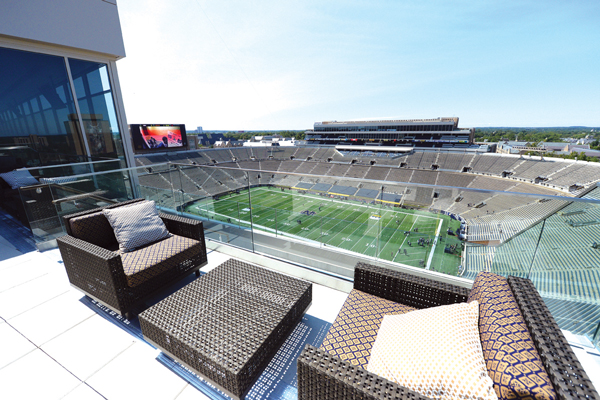 |
Patios have views of field, campus.
Photo by: DAVID DUROCHIK |
Improving the game-day experience for both the fans and the football program were part of the equation, but the project was critical for resolving other school needs connected to one of the most valuable pieces of campus real estate, Notre Dame Athletic Director Jack Swarbrick said.
“We had to address how to make [the stadium] more useful, given its location,” Swarbrick said.
The three new buildings attached to the stadium structure introduce premium seats for Notre Dame football, in addition to creating new classrooms, student recreational facilities, a digital media center, two music performance halls and a career services center.
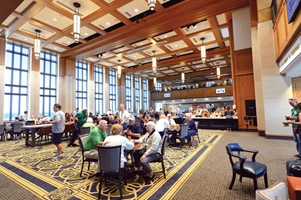 |
Stately design, comfortable furnishings are highlights of the club areas.
Photo by: DAVID DUROCHIK |
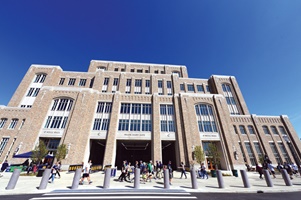 |
The project is part stadium upgrade, part classroom additions.
Photo by: DAVID DUROCHIK |
The expansion touches virtually every Notre Dame student. For example, all psychology, anthropology and music education majors will attend classes at the expanded stadium after those programs moved their operations from elsewhere on campus, Swarbrick said.
Those in need of a workout can run on the indoor running track, use the climbing wall or shoot hoops on the basketball court. (The Duncan Student Center on the west side remains under construction and is set to open in January.)
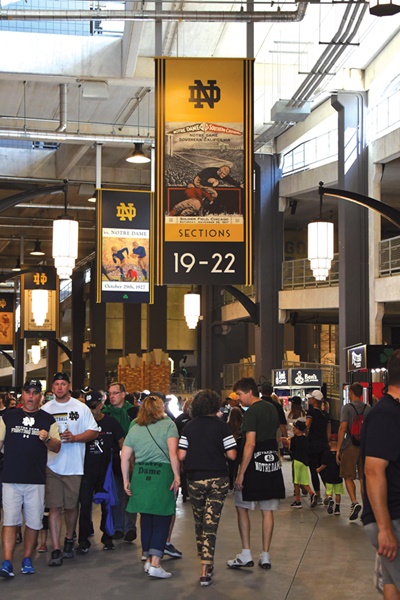 |
Redesigned concourses recall the history of the program and the stadium.
Photo by: DAVID DUROCHIK |
Others may attend special events apart from football games in the 10,000-square-foot Dahnke Ballroom and the other new hospitality spaces. The Rex and Alice Martin Digital Media Center plays a key role in teaching students and providing the technology for the ACC Network, launching in 2019.
“In a world that’s become increasingly cynical about the ability for athletics and the academic mission for universities to co-exist, we see this project as a really important symbol that they can,” Swarbrick said. “We want it to be understood in those terms.”
Make no mistake, though: Football paid the freight for the project, called Campus Crossroads. The addition of club seats and loge boxes along both sidelines sold on 20-year terms financed the project, as well as the philanthropic gifts to name the individual floors tied to those premium seats.
In general, most premium inventory is sold out with the exception of some seats held back for business prospects and single-game sales. Club seats cost $3,500 to $6,000 a person annually, plus one-time capital gifts of $15,000 to $30,000.
The 68 loge boxes bookending two of the three premium levels cost $5,500 to $6,500 annually and come with tablets equipped with Bypass technology for ordering food and drink. The tablet also serves as a television with live feeds, game replays and unique viewing angles.
Apart from two suites reserved for the athletic director and school president, four corporate suites on the ninth floor of the west side are sold for single games only. The cost runs $650 to $1,000 a person depending on the game for suites with 18 to 32 fixed seats plus drink-rail seats.
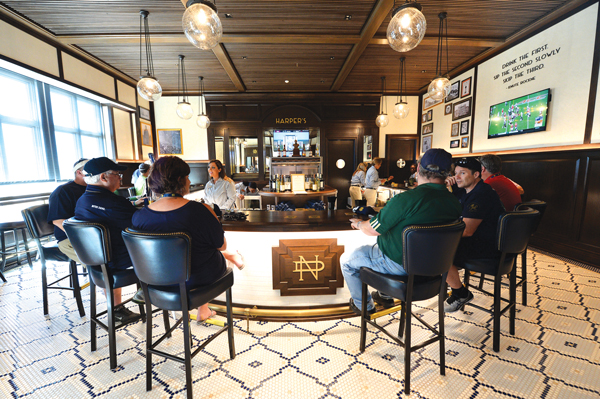 |
Harper’s, the bar in the back of the South Club, is named for Notre Dame’s first athletic director.
Photo by: DAVID DUROCHIK |
“We weren’t trying to make the most lavish premium spaces,” Swarbrick said. “That wasn’t our direction here. … Some of the [outdoor patio] spaces we built [on the seventh and ninth floors] are oriented to look at campus, not necessarily the game.”
All premium seats are sold as an all-inclusive ticket package, including beer and wine. Hard liquor is exclusive to the 1842 Club and the South Club, a membership-only club.
Location: South Bend, Ind.
Project cost: $400 million
Size of expansion: 800,000 square feet
Architects: HOK, Slam Collaborative, Ratio Architects, Workshop Architects, IDS, Cardosi Kiper, Champalimaud
General contractor: Barton Malow
Sales agency: Legends Global Sales
Consultants: CSL International (feasibility), ADMI (theming)
Premium seats: 2,100 club seats, 68 loge boxes, four single-game suites
Concessionaire: Levy
Technology: ANC/Mitsubishi (video board), AmpThink (Wi-Fi), Crown Castle (distributed antenna system), Bypass (mobile point-of-sale), Musco (LED sports lighting)
Sustainability: Projected for LEED Silver certification
University spaces: 242 faculty/staff offices, 26 classroms/labs, 33 psychology research labs, 24 music practice/rehearsal rooms, two performance halls
Sources: Notre Dame, SportsBusiness Journal research
The new premium levels, most of which were built on what now consists of the seventh, eighth and ninth floors on the east and west sides, are all supported by themed lounges, such as the ninth floor’s 7 on 9 Club, named for Notre Dame’s seven Heisman Trophy winners.
The exception is the 1842 Club, situated on the fifth floor on the west side, closest to the field. Named for the year the school was founded, it’s a retrofit of the old press box and the most exclusive premium space reserved for the university’s biggest donors. The lounge itself features a communal fireplace, dark wood finishes, high-end furniture and decorative rugs. An adjacent bar caters to the 163 patrons holding tickets to outdoor seats with heating coils installed underneath. They’re the only heated seats in the college space with that particular design, project officials said.
“You might get wet [on a rainy Saturday], but you will be warm,” said Missy Conboy, Notre Dame’s senior deputy athletic director.
The South Club is a “hidden gem” thanks to the design, said Beth Hunter, an associate athletic director. Built on the fourth floor in the south end, the look of the gastro pub differs from the stateliness of the other premium spaces.
The club came late in the development and has no views to the field. It’s limited to 325 people who pay a fee of $5,000 for a 10-year membership. They also pay $2,000 a year for every season ticket. In return, they get unlimited food and drink and access to the school’s postgame radio show, which takes place in the club’s center dining room. Harper’s, the sit-down bar at the back of the club, is named for Jesse Harper, who was Notre Dame’s football coach and its first athletic director in the early 20th century.
The club itself showcases the stadium’s most extensive collection of Notre Dame memorabilia and recognizes every athletic director in school history, some in their playing days competing for the Irish such as Mike Wadsworth (football) and Dick Rosenthal (basketball).
Several passages attributed to legendary coach Knute Rockne are showcased on the stadium walls as part of the upgrades, and one of his quotes on display in the South Club catches the patron’s eye: “Drink the first. Sip the second slowly. Skip the third.”
Overall, Conboy and Hunter spent months poring over Notre Dame Archives to come up with the right mix of images and historical references. On the concourses, reproductions of 70 game program covers stretching from the 1920s to the 1960s hang from the ceilings as directional signs.
 |
The 1842 Club is reserved for the university’s biggest donors.
Photo by: DAVID DUROCHIK |
The game program signs, the vintage light fixtures and ironwork, plus the new limestone and brick facades consistent with other campus buildings, bring the retro look back to a stadium that lost a big chunk of its place in time after the last stadium expansion in 1997.
Twenty years ago, the concrete pillars supporting 20,000 new seats effectively wiped away the period elements of the original structure, Conboy said. In some spots, the old and new brick differed in color, but some touch-ups helped make them a match.
In all levels of the stadium, the wood benches that made up the old seating bowl have been repurposed, extending from frames holding large graphics of old ticket stubs and drink rails on the main concourse to the walls of the four corporate suites and dining booths in the South Club.
“You feel Notre Dame’s rich history much stronger in this building now than you used to,” Swarbrick said.










